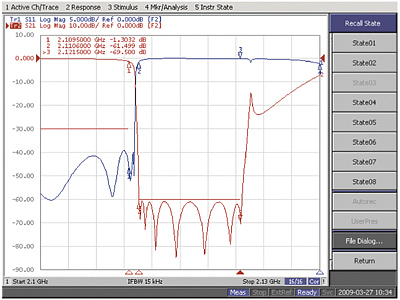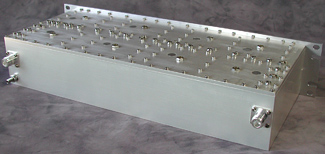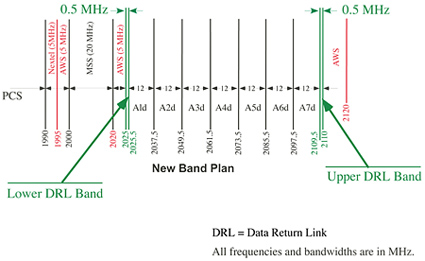New AWS Band Reject Filter Developed
SAN FRANCISCO
As stations transition their ENG operations to digital, many of them are finding that interference from Advanced Wireless Services (AWS) base stations into ENG receive only sites is not idle speculation.
Beginning in mid-December, 2006, several major New York City TV station ENG-RO sites began experiencing interference; one receive site, in Queens, became unusable.
It was later discovered that the source of the interference was an experimental Special Temporary Authority (STA) station, WC9XSK, also located in Queens. This experimental STA had been issued to Ericsson Inc., a major manufacturer of AWS base station radios. Under the WC9XSK experimental STA, Ericsson was authorized to deploy approximately fifty 2.1 GHz AWS base stations in the Queens area. Although the WC9XSK STA had a special condition, namely that "Operations are subject to prior coordination with local point-to-point microwave, AWS and TV Pickup licensees," unfortunately no such prior coordination occurred with the New York city area TV Broadcast Auxiliary Services (BAS) licensees, and the TV station operator had to track down the interference itself.

Fig. 1: Sweep response of the CMT Model CMN719 AWS band reject filter. The red trace is the filter's insertion loss in dB. The blue trace is the filter's return loss in dB. ©CMT, used with permission But, at least Ericsson promptly shut down the test operations when informed of the interference. As an interim fix, no subsequent tests were conducted in the late afternoon period, when ENG operations were heaviest, and the test operations were limited to the upper half of the AWS band (i.e., 2,115–2,120 MHz); this minimized the interference into the ENG-RO site, which had TV BAS Channel A7 (2,093–2,110 MHz) for its home channel—this is this top-of-the-band channel that is most at risk of AWS-into-ENG interference.
In some ways this incident was helpful because it demonstrated that AWS-into-ENG interference was a real—as opposed to a theoretical—interference threat, and one needing a long-term solution.
Of course, since Part 5 experimental operations are always on a no-interference-basis (NIB) to any licensed operations, there was no question that the TV Pickup operations of the New York City TV station trumped the WC9XSK operation. However, once an AWS auction winner activates its network of Part 27 base stations, it becomes one licensed service versus another licensed service, and broadcasters' protection then hinges on Sections 27.53(h) and 27.1133 of the AWS rules (more on this later).
INDISTINGUISHABLE FROM MAGIC?
To solve the AWS-into-TV BAS problem, T-Mobile, Inc., a major AWS auction winner, worked with a California filter manufacturer, Commercial Microwave Technology, Inc. (CMT), to develop an AWS band reject filter that could be used to protect sensitive 2 GHz TV BAS central receive sites from brute force overload (BFO) interference.

Fig. 2: Front view of the CMT AWS band reject filter. ©CMT, used with permission What CMT came up with was pretty amazing, in this writer's opinion. Indeed, the late science fiction writer Arthur C. Clarke wrote, "Any sufficiently advanced technology is indistinguishable from magic."
The CMT filter comes close to meeting this "magic" criteria. As shown by Figures 1–3, the filter has more than 60 dB of attenuation in the AWS band, but only 1.3 dB of attenuation across TV BAS Channel A7d (2,097.5–2,109.5 MHz). All this in a filter that is only two rack units high. As shown by Fig. 4, the AWS band is immediately above the 2 GHz TV BAS band.
To its credit, T-Mobile has taken seriously its obligation under Section 27.1133 of the FCC Rules, which requires newcomer AWS operators to protect 2 GHz Part 74 and Part 78 operations. This means being prepared to retrofit an earlier-in-time ENG-RO site that is located close to an AWS base station with one of these remarkable CMT band reject filters. In some cases, additional filtering of the AWS base station's out-of-band emissions (OOBE) may also be necessary, pursuant to Section 27.53(h) of the FCC Rules, although so far the dominant interference mechanism has been BFO and not OOBE. Part 27 of the FCC Rules is called the "Miscellaneous Wireless Communications Service," (really, that's its name); AWS stations come under Subpart L of those rules; thus, when an up to 1,640-watt equivalent isotropic radiated power (EIRP) AWS base station fires up too close to an existing ENG-RO site, the TV station operator may think that the site's performance has "gone to L."
ABC REPORT

Fig. 3: Rear view of the CMT filter. ©CMT, used with permission In December 2008, Craig Strom, assistant director of engineering for Chicago ABC affiliate WLS-TV, and the Chicago area above 1-GHz BAS frequency coordinator, wrote a thorough study, "T-Mobile AWS Filter Implementation Progress Report," regarding the effectiveness of the CMT filter. It documented that the filter was effective in eliminating BFO from a nearby AWS base station.
Equally important, the report showed that the filter's group delay across TV BAS Channel A7d did not degrade digital ENG signals. This is of critical importance, because while analog FM video ENG signals are relatively forgiving of group delay errors, digital signals tend to be much more sensitive to varying group delay across an ENG channel. And the more sharply tuned that a filter becomes, then usually the more extreme are the group delay changes near the filter's edge. Therefore the report's testing of multiple modes of digital ENG operation, and conclusion that the filter did not degrade those operations, was a finding of great importance.
SBE PETITION
In September 2005, the Society of Broadcast Engineers filed what became RM-11308, a Petition for Rulemaking with the FCC. SBE asked that the Universal Licensing System (ULS) be modified to allow (but not require) TV Pickup licensees to enter the location(s) and height(s) of their ENG-RO sites into the ULS, so that it could be searched on a frequency/point-radius basis by any interested party. A year ago, the FCC adopted SBE's proposal, so now the ULS can show TV Pickup licensees' ENG-RO sites.

Fig. 4: The re-farmed 2,025–2,110 MHz TV BAS band. The AWS band is immediately above the 2 GHz TV BAS band, with only the 0.5 MHz upper data return link (DRL) band between an AWS base station and TV BAS Channel A7d. ©CMT, used with permission Why should all TV Pickup licensees with ENG-RO sites run, not walk, to the ULS to register their sites? Because doing so makes it more likely that a newcomer AWS operator will be able to determine in advance the locations of such sites, and either avoid constructing an adjacent-band AWS base station in close proximity, or, if this cannot be avoided, to at least give the ENG-RO site operator a heads up, and conduct interference tests before the AWS base station gets placed into regular operation. This is important because once an AWS cell goes from the equivalent of equipment tests to program tests, and subscribers get used to having service provided by that cell, reducing the cell's power, or relocating the cell, becomes less likely. It's the classic case of an ounce of prevention is worth a pound of cure.
SUMMARY
These are "interesting times" for 2 GHz TV BAS operations; other services want a piece of the 2 GHz band with its favorable propagation characteristics. To keep a station's ENG operations viable, some of the receive sites will probably have to be retrofitted with an AWS band reject filter, and all of the ENG-RO sites should be registered in the ULS. Although this means filing an FCC Form 601 modification application to add these sites to the TV Pickup license, doing so would be prudent in this writer's opinion.
Finally, kudos to ABC, Mr. Craig Strom, T-Mobile, and of course CMT.
Dane E. Ericksen, P.E., CSRTE, 8-VSB, CBNT, is a senior engineer with Hammett & Edison Inc., San Francisco. He has served multiple terms on the SBE national board, chaired the SBE FCC Liaison Committee from 1987–2007 (now SBE Government Relations Committee), and chairs the ATSG TSG S3 Specialist Group on Digital ENG. He can be reached atdericksen@h-e.com.
The professional video industry's #1 source for news, trends and product and tech information. Sign up below.
